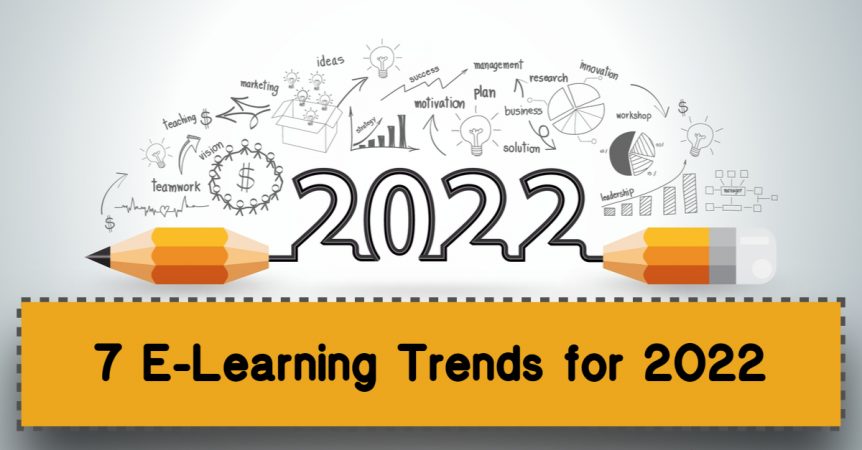7 E-Learning Trends for 2022
What e-learning trends do you need to look out for in 2022 and beyond?
With the corporate training landscape continuing to evolve at a rapid pace, it is an interesting time to look at this question. New technologies are becoming increasingly available, for example, plus there are rising expectations from learners, training professionals, and senior executives.
The changing nature of business also makes it essential to adapt, improve, and optimise how organisations train their employees. Digital transformation in business is one of the main drivers of these changes.
Let’s look at seven e-learning trends that will influence e-learning and corporate training over the coming 12 months.
-
Immersive Learning Experiences
Immersive training usually refers to the use of virtual reality (VR), augmented reality (AR), and mixed reality (MR). These extended reality (XR) technologies are becoming an increasing feature in corporate training as they can bring the learner closer to the topic in an environment that is completely safe.
Personalised training, branching scenarios, and interactive videos are other methods that can be used to make e-learning courses more immersive for the learner.
-
Artificial Intelligence (AI)
Machine learning and AI technologies continue to develop in all industries and sectors, and e-learning is no different. New AI technologies are improving the delivery of personalised training where learners are presented with content that is completely tailored to their needs.
AI technologies can also be used in the analysis of training data to inform strategy development and improve decision-making around training goals and objectives.
-
Adaptive Learning
Adaptive learning is a training model that delivers personalised training experiences to learners. As mentioned in the previous point, this can be achieved through AI technologies, but there are also other ways of developing adaptive learning.
When it is used in the right situations, adaptive learning can improve training outcomes and help you achieve your objectives. It is not a new concept, but it is becoming more commonly used.
-
Microlearning
One of the things that most workers have very little of is time. This lack of time can make it difficult to develop skills and get the training that is needed to maximise productivity, improve performance, and ensure you are equipped for the future.
Microlearning can be part of the solution to this challenge of time pressures. Microlearning presents content to learners in short, bite-sized chunks that only take a few minutes to complete. It also empowers learners to complete the training they need at a time that best suits them.
-
Big Data
Big data is another technology that is helping businesses in a range of areas. It can help with the development and delivery of your training strategy too. With big data, data analytics, and data visualisation technologies, decision-making becomes more efficient, and you can improve the quality of decision-making.
Big data is also set to become increasingly important in the personalisation of training, particularly when combined with AI technologies and adaptive learning strategies.
-
Gamification
Gamification is a trend that has been featured on annual lists like this for some time now. Even though it has been a feature in the past, it not only continues to be important, but is becoming even more essential.
One of the main reasons for using gamification in e-learning is to increase levels of engagement and improve the learning experience. Both are still beneficial, but adding gamified elements also helps improve training outcomes. Gamification can make it easier for learners to acquire new knowledge and skills, and it helps them practice what they have learned.
-
Continuous Learning Culture
The focus of organisations to develop a continuous learning culture is the final trend on this list, plus it is the only one not directly connected to a new technology. It is arguably the most important, however, as the way organisations operate is changing. Those changes are being influenced by several common challenges, including:
- Skills shortages in certain sectors
- Cost of recruitment compared to staff retention
- Development of new technologies
- Digital transformation strategies
- Compliance requirements
- Too much reliance on small groups of people with specific skillsets
These challenges have put a spotlight on the need for a continuous learning culture in forward-thinking organisations. That spotlight will remain throughout 2022 and beyond.
A continuous learning culture is more than having a formalised continuous professional development (CPD) programme. That is important, too, of course. However, establishing and nurturing a continuous learning culture goes beyond this. It is about lifelong learning and making it the norm to develop new skills and learn new information in formal and informal settings, in work and outside.
Shaping the Future
For organisations in many industries, it has never been more important to train employees and develop new skills within your existing team. E-learning, along with the technologies and strategies highlighted above, will continue to play a crucial role in ensuring organisations have the skilled people they need to remain profitable and competitive, and to deliver on the expectations of their customers.
